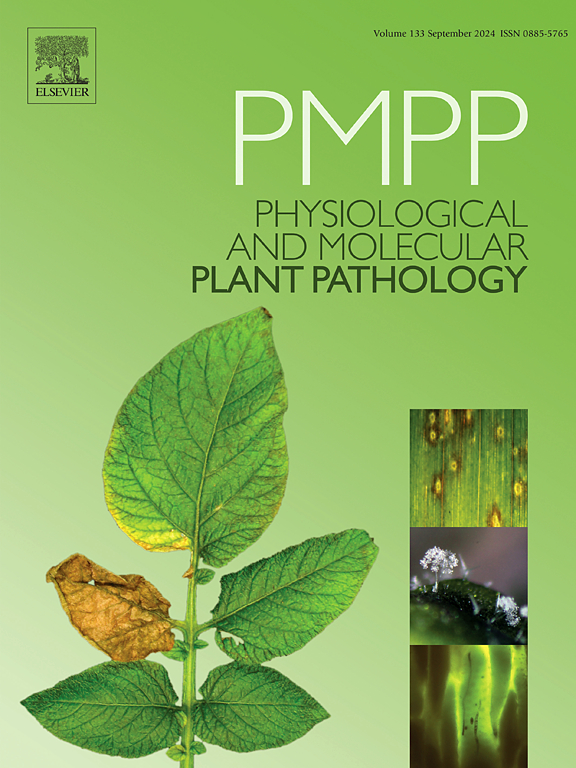碳酸盐和重碳酸盐:管理植物病虫害和非生物胁迫的可持续方法
IF 2.8
3区 农林科学
Q2 PLANT SCIENCES
引用次数: 0
摘要
不断增长的全球粮食需求要求采取可持续的农业做法,尽量减少对环境的影响,同时确保高产。合成农药虽然对作物保护至关重要,但也引起了人们对环境污染、耐药性发展和对非目标生物的危害的担忧。碳酸盐和碳酸氢盐(如NaHCO3、KHCO3、CaCO3)为综合病虫害管理和缓解非生物胁迫提供了一种有前途的、公认安全的(GRAS)替代品。这些化合物对多种真菌、卵菌、细菌和昆虫病原体,包括棒根原生生物(芸苔菌)具有广谱功效。它们的直接抗菌机制包括破坏病原体细胞膜和细胞壁,诱导渗透应激,改变pH值,从而导致病原体死亡。除了直接毒性外,碳酸盐和碳酸氢盐还会引发植物防御,诱导系统获得性抗性(SAR)和刺激防御酶(如过氧化物酶、多酚氧化酶)。此外,它们通过提高pH值、改善养分有效性、结构和保水性来改善土壤健康,同时降低重金属的生物有效性。这些土壤改良提高了植物对干旱、盐度和金属毒性的抵御能力,改善气孔调节也带来了潜在的好处。最近的进展是引入碳酸盐纳米颗粒作为纳米杀菌剂和生物刺激剂,以更低的施用量提供更高的功效。将碳酸盐/碳酸氢盐纳入病虫害综合治理(IPM)计划,特别是与生物防治剂和其他有益盐类联合使用,显示出协同效应,减少了对传统农药的依赖。然而,需要进一步的研究来阐明详细的分子机制,评估长期土壤影响,优化施用方法(如叶面喷雾,土壤改良剂,纳米配方),并评估与其他农用化学品的相容性。解决这些知识差距将使这些可持续化合物充分发挥潜力,促进有抵御力和粮食安全的农业。本文章由计算机程序翻译,如有差异,请以英文原文为准。
Carbonates and bicarbonates: A sustainable approach for managing plant diseases, pests, and abiotic stresses
The growing global food demand necessitates sustainable agricultural practices that minimize environmental impact while ensuring high yields. Synthetic pesticides, while crucial for crop protection, raise concerns about environmental contamination, resistance development, and harm to non-target organisms. Carbonates and bicarbonates (e.g., NaHCO3, KHCO3, CaCO3) offer a promising, Generally Recognized as Safe (GRAS) alternative for integrated pest and disease management and abiotic stress mitigation. These compounds exhibit broad-spectrum efficacy against diverse fungal, oomycete, bacterial, and insect pathogens, including the clubroot protist (Plasmodiophora brassicae). Their direct antimicrobial mechanisms involve disrupting pathogen cell membranes and walls, inducing osmotic stress, and altering pH, which leads to pathogen death. Beyond direct toxicity, carbonates and bicarbonates also elicit plant defenses, inducing systemic acquired resistance (SAR) and stimulating defense enzymes (e.g., peroxidase, polyphenol oxidase). Furthermore, they enhance soil health by raising pH, improving nutrient availability, structure, and water retention, while reducing heavy metal bioavailability. These soil improvements increase plant resilience to drought, salinity, and metal toxicity, with potential benefits also arising from improved stomatal regulation. Recent advancements have introduced carbonate nanoparticles as nano-fungicides and biostimulants, offering enhanced efficacy at lower application rates. Integrating carbonates/bicarbonates into Integrated pest management (IPM) programs, especially in combination with biocontrol agents and other beneficial salts, demonstrates synergistic effects and reduces reliance on conventional pesticides. However, further research is needed to elucidate detailed molecular mechanisms, assess long-term soil impacts, optimize application methods (e.g., foliar sprays, soil amendments, nanoformulations), and evaluate compatibility with other agrochemicals. Addressing these knowledge gaps will enable the full potential of these sustainable compounds for resilient and food-secure agriculture.
求助全文
通过发布文献求助,成功后即可免费获取论文全文。
去求助
来源期刊
CiteScore
4.30
自引率
7.40%
发文量
130
审稿时长
38 days
期刊介绍:
Physiological and Molecular Plant Pathology provides an International forum for original research papers, reviews, and commentaries on all aspects of the molecular biology, biochemistry, physiology, histology and cytology, genetics and evolution of plant-microbe interactions.
Papers on all kinds of infective pathogen, including viruses, prokaryotes, fungi, and nematodes, as well as mutualistic organisms such as Rhizobium and mycorrhyzal fungi, are acceptable as long as they have a bearing on the interaction between pathogen and plant.

 求助内容:
求助内容: 应助结果提醒方式:
应助结果提醒方式:


